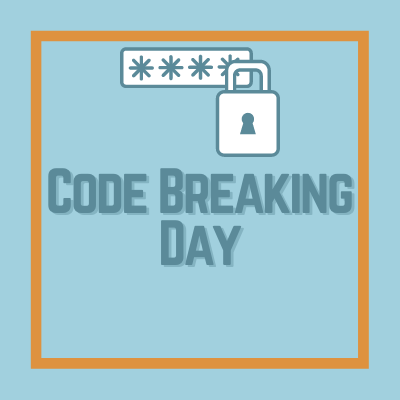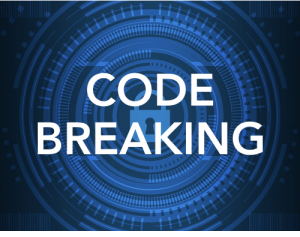Code-Breaking Day
Ages: 8-12 years
Materials: paper, pens, scissors, compass or disk shapes
Time: 1-2 hrs
Complexity: easy to mid-level

One example of a secret code method is called a Keyword Cipher. With this secret code, a keyword is placed at the beginning of the alphabet. This shifts all of the remaining letters of the alphabet to the right.
For example, if the keyword was JAMESBOND, the code would read as follows:
The message: SEND HELP QUICKLY would be encoded as RSIE NSGL PUDMFGY.
Here is a challenge for you to try – use the JAMESBOND keyword cipher to break the code and find the answer to this question:
Q. In the James Bond film The Man With The Golden Gun, how many shots does Scaramanga have with his Golden Gun?
A. GDHDTSE TK CURT KIS AUGGST
Hint: When trying to crack a cipher, the relative frequency of letters in the written word will sometimes reveal the code. ‘For example, ‘e’ is the most frequently-used letter in the alphabet. If you’re decoding a paragraph with lots of h’s, you might reasonably guess that ‘e’ has been replaced by ‘h’ in the code.
Organising your code-breaking day
There are many different types of secret codes and you can organise different types of challenges for students to take part in.
- Time based challenge: student teams move around a room such as a classroom or hall trying to decode messages to find the hidden meaning. For each challenge they are given a set amount of time. Points are awarded depending on how many codes their team solves.
- Solution based challenge: teams are given code-breaking challenges. Once the team has decoded the message correctly they are given the next.
- Week-long challenge: a set of coded messages are given out at the beginning of the week to all students in the school.
- Daily code-breaking challenges: secret codes are given out daily.
Whatever format you decide is appropriate for your Code-Breaking Day, browse the resources below to find a wealth of fun code-breaking activities and puzzles to occupy participants.

More code-breaking resources
Codes and Ciphers Teaching Resources Website Great resource for your code breaking day on Substitution Ciphers, Braille, Bar Codes, ISBN Numbers, Genetic Fingerprinting, Postcodes, Semaphore, Morse Code, and many others. Each comes with lesson plans, pupil information and exercises, and teacher notes
Secret Code Breaker Learn all about secret codes including Caesar Ciphers, Auto Key Ciphers, and Monoalphabetic Substitution Ciphers. Online and downloadable solvers are provided for many of the common ciphers. The website also contains some interesting history stories on code breaking
Kids Spy Equipment Fun website on how to make spy equipment How to build a periscope, Keyhole spy tool, Spy ID card, Make Invisible Ink and Fingerprint powder
The Secret World of Codes and Code Breaking Stories to use for background history on code-breaking
Recommended books on code-breaking
The Secret Life of Codes (Murderous Maths) by Kjartan Poskitt Readers will learn how to encode and decode their own messages in as many ways as possible with Poskitt hilarious characters.
The Code Book: The Secret History of Codes and Code-breaking by Simon Singh Contains many fascinating accounts of code-breaking in action, from its use in unmasking the Man in the Iron Mask and the defeat of the Nazis to the breaking of a modern cipher system by a world-wide army of amateurs in 1994.
Creating the Coding Generation in Primary Schools Dr Maths’ (aka Steve Humble’s) book on code breaking.
